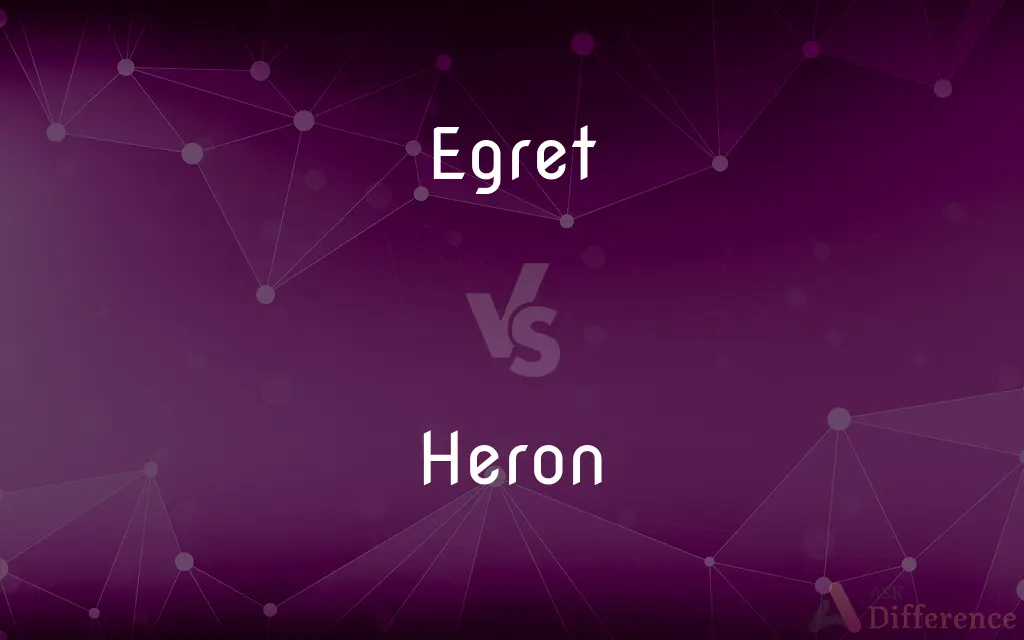Egret vs. Heron — What's the Difference?
By Maham Liaqat & Fiza Rafique — Updated on March 7, 2024
Egrets and herons are both long-legged, freshwater and coastal birds but differ in size and coloration.

Difference Between Egret and Heron
Table of Contents
ADVERTISEMENT
Key Differences
Egrets are often white and part of the heron family, known for their graceful appearance and plumes. They are associated with purity and elegance in various cultures. Herons, on the other hand, come in a wider range of colors, including blues, grays, and browns, and are distinguished by their larger size and broader wingspan compared to egrets. Herons are adaptable birds, found in a variety of watery environments worldwide, known for their solitary fishing technique.
While egrets are generally smaller and have sleek bodies with sharp beaks used for fishing, herons display a greater variety in size and have a more robust build with a wider range of beak shapes to suit their diverse diets, which can include fish, amphibians, and insects. The distinctive plumes of egrets, especially during the breeding season, are a notable feature that has historically led to their feathers being highly prized.
Both egrets and herons are wading birds, using their long legs to navigate through shallow waters in search of food. However, egrets tend to have more uniformly slender legs with black, yellow, or red coloration, while herons' legs can be thicker with varying colors, often blending more with their overall body coloration.
Egrets and herons play significant roles in their ecosystems as predators of aquatic animals. They are often seen standing still in water, waiting to spear prey with their sharp beaks. Despite their similarities, egrets' association with whiteness and lightness contrasts with herons' broader color palette and size range, reflecting the diversity within the Ardeidae family.
Comparison Chart
Size
Generally smaller
Larger with a broader wingspan
ADVERTISEMENT
Color
Mainly white
Varies (blues, grays, browns)
Plumes
Notable, especially during breeding
Less prominent plumes
Beak Shape
Sharp and pointed for fishing
Wider range of shapes for diverse diet
Leg Thickness
Slimmer
Can be thicker
Cultural Symbolism
Associated with purity and elegance
Symbolizes patience and solitude
Compare with Definitions
Egret
Typically smaller and slimmer than herons.
Egrets are easily identified by their slender build.
Heron
Feeds on fish, amphibians, and insects.
The heron skillfully caught a frog hiding in the reeds.
Egret
A white bird of the heron family, known for its elegant appearance.
The egret stood gracefully by the water's edge.
Heron
A large bird with a wide wingspan and varied coloration.
The blue heron stood tall by the lakeside.
Egret
Has distinctive breeding plumes.
In breeding season, egrets display beautiful long plumes.
Heron
Known for their solitary fishing technique.
The heron waited patiently for hours to catch its prey.
Egret
Feeds mainly on fish and small aquatic creatures.
The egret darted its beak into the water to catch fish.
Heron
Has a broader range of beak shapes and sizes.
The heron's stout beak is ideal for catching a variety of prey.
Egret
Often symbolizes purity and elegance.
The white egret is a symbol of purity in many cultures.
Heron
Represents patience and solitude in various cultures.
In many stories, the heron symbolizes a solitary and wise character.
Egret
Egrets are herons that have white or buff plumage, developing fine plumes (usually milky white) during the breeding season. Egrets are not a biologically distinct group from herons and have the same build.
Heron
The herons are long-legged, long-necked, freshwater and coastal birds in the family Ardeidae, with 64 recognised species, some of which are referred to as egrets or bitterns rather than herons. Members of the genera Botaurus and Ixobrychus are referred to as bitterns, and, together with the zigzag heron, or zigzag bittern, in the monotypic genus Zebrilus, form a monophyletic group within the Ardeidae.
Egret
Any of several usually white herons of the genera Ardea, Bubulcus, and Egretta, characteristically having long, showy plumes during the breeding season.
Heron
A large fish-eating wading bird with long legs, a long S-shaped neck, and a long pointed bill.
Egret
Any of various wading birds of the genera Egretta or Ardea that includes herons, many of which are white or buff, and several of which develop fine plumes during the breeding season.
Heron
Any of various wading birds of the family Ardeidae, having a long neck, long legs, a long pointed bill, and usually white, gray, or bluish-gray plumage.
Egret
A plume or tuft of feathers worn as a part of a headdress, or anything imitating such an ornament.
Heron
A long-legged, long-necked wading bird of the family Ardeidae.
Egret
(botany) The flying feathery or hairy crown of seeds or achenes, such as the down of the thistle.
Heron
Any wading bird of the genus Ardea and allied genera, of the family Ardeidæ. The herons have a long, sharp bill, and long legs and toes, with the claw of the middle toe toothed. The common European heron (Ardea cinerea) is remarkable for its directly ascending flight, and was formerly hunted with the larger falcons.
Egret
(obsolete) The crab-eating macaque (Macaca fascicularis)
Heron
Greek mathematician and inventor who devised a way to determine the area of a triangle and who described various mechanical devices (first century)
Egret
The name of several species of herons which bear plumes on the back. They are generally white. Among the best known species are the American egret (Ardea egretta syn. Herodias egretta); the great egret (Ardea alba); the little egret (Ardea garzetta), of Europe; and the American snowy egret (Ardea candidissima).
A bunch of egrets killed for their plumage.
Heron
Gray or white wading bird with long neck and long legs and (usually) long bill
Egret
A plume or tuft of feathers worn as a part of a headdress, or anything imitating such an ornament; an aigrette.
Egret
The flying feathery or hairy crown of seeds or achenes, as the down of the thistle.
Egret
A kind of ape.
Egret
Any of various usually white herons having long plumes during breeding season
Common Curiosities
Are all white herons considered egrets?
While most white herons are referred to as egrets, not all egrets are white; some heron species can also be white.
Do egrets and herons migrate?
Some species of egrets and herons migrate, while others are resident birds, depending on their habitat and climate.
How do herons' beaks adapt to their diet?
Herons have a variety of beak shapes to suit their diverse diets, ranging from fish to small amphibians and insects.
What distinguishes an egret from a heron?
Egrets are typically smaller, mainly white, and have distinctive breeding plumes, whereas herons are larger, come in various colors, and have a broader range of beak shapes.
Can egrets and herons be found in the same habitats?
Yes, both egrets and herons can often be found in similar watery environments, such as marshes, rivers, and lakes.
How do egrets and herons hunt for food?
Both egrets and herons hunt by wading in shallow water and suddenly striking prey with their sharp beaks.
How do herons and egrets contribute to their ecosystems?
As predators of aquatic animals, herons and egrets help control the populations of fish and insects, contributing to the balance of their ecosystems.
Do egrets nest in colonies?
Yes, many egret species nest in colonies, often alongside other waterbirds, in trees or shrubs near water bodies.
How do egrets communicate?
Egrets communicate through a range of vocalizations and body language, especially during breeding season to attract mates and establish territories.
Are herons active during the day or night?
Many heron species are primarily active at dawn and dusk (crepuscular), but some may also be active during the day or night.
Are egret plumes still used in fashion?
Egret plumes were once highly prized for fashion, but this practice has significantly declined due to conservation efforts.
What is the significance of the egret in culture?
Egrets are often associated with purity and elegance, featuring in various cultural symbols and stories.
How do herons and egrets deal with predators?
Herons and egrets use various strategies to deal with predators, including camouflage, flying away, and using their sharp beaks for defense.
What challenges do herons face in their habitats?
Herons can face challenges such as habitat loss, pollution, and climate change, which affect their feeding grounds and nesting sites.
What conservation efforts are in place for herons and egrets?
Conservation efforts for herons and egrets include habitat protection, pollution control, and monitoring populations to ensure their survival.
Share Your Discovery

Previous Comparison
Workshop vs. Studio
Next Comparison
Unicode vs. AsciiAuthor Spotlight
Written by
Maham LiaqatCo-written by
Fiza RafiqueFiza Rafique is a skilled content writer at AskDifference.com, where she meticulously refines and enhances written pieces. Drawing from her vast editorial expertise, Fiza ensures clarity, accuracy, and precision in every article. Passionate about language, she continually seeks to elevate the quality of content for readers worldwide.














































